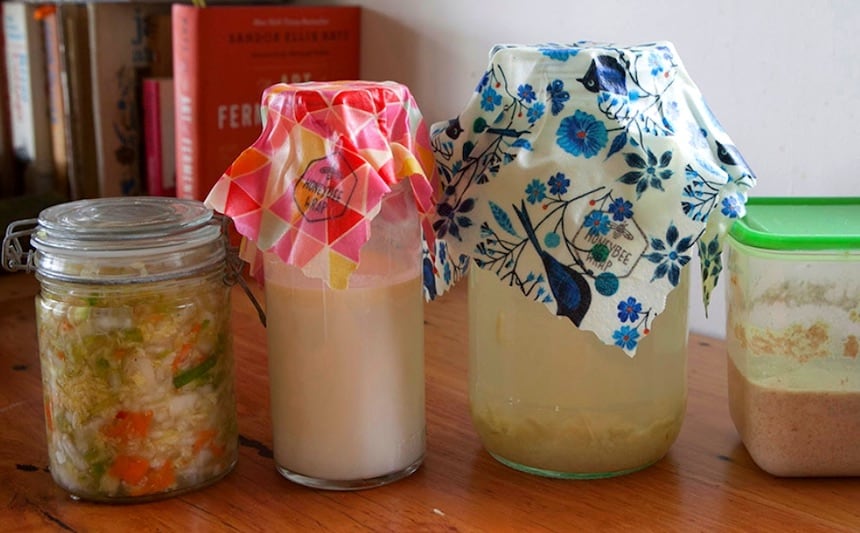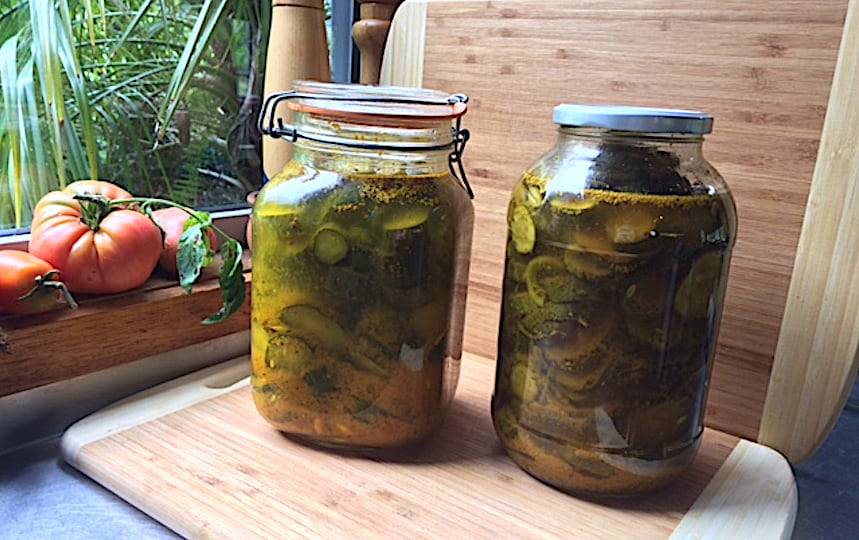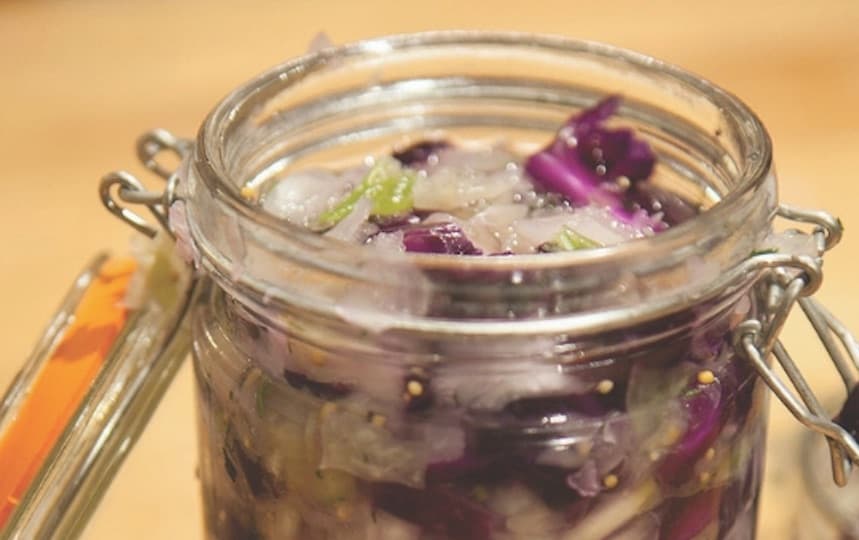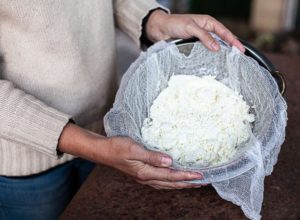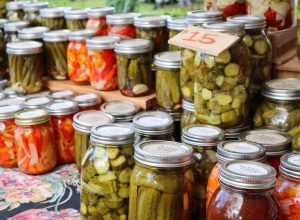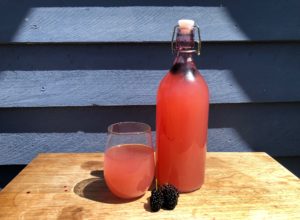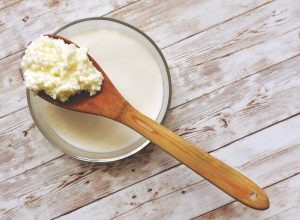Making ferments is an organic artform with endless variations, smells, textures and tastes. Our fermenting troubleshooting guide will help you get it right.
Our resident fermenting queen Emily Stokes answers all your fermenting questions in our fermenting troubleshooting guide. If you a question of your own, enter it into the comments below and we will answer it.
Fermenting Troubleshooting Guide
1. Is it healthy to make preserves using vinegar? (Heather, NSW)
The method of preserving food with vinegar has only been around since industrialisation. It came in as a quick and easy way to keep food shelf stable so it would be saleable for longer. A much healthier way to preserve your food is through the process of lacto-fermentation. This is how people preserved their food long before fridges and canning became popular.
Lacto-fermentation is how traditional sauerkraut and kimchi are made. The vegetables are simply crushed with salt, stuffed in a jar or crock and pushed down until the liquid comes to the top.
It’s this process of anaerobic fermentation that preserves the food through encouraging the lactobacilli bacteria to proliferate (the same bacteria that are probiotic for your gut).
At this time of year, you can stuff your cucumbers into a jar under a saltwater brine. They will be preserved for many months, and not only that, they will contribute to a healthier gut flora every time you pull one out to have on a cracker with cheese.
2. I tried using a salt water brine to make cucumber pickles, but my cucumbers went soggy. What can I do? (Sally, ACT)
There are a few ways you can keep the crunch in your lacto-fermented cucumber pickles. Try scratching off the blossom end of the cucumber before you pickle it in brine, because the blossom end has enzymes that cause softening.
Try using whole small cucumbers instead of slicing up larger cucumbers. Add something with tannins in it to keep the crunch in your pickles (for example, a tea bag, grape leaves, horseradish leaves or oak leaves).
Lastly, try to slow the fermentation down a bit by leaving your jar somewhere cool to ferment rather than the hottest part of the kitchen.
3. I made a salt water brine for my carrot sticks and left it on the bench to ferment for a week or two. It went kind of slimy. Is it still okay to eat? (Robyn, NSW)
When you make a traditional lacto-ferment such as you have with the salt water brine, a wide variety of bacteria and yeasts will be present to culture your vegetables.
If your vegetables have gone a bit slimy, have a strong odour or have grown some mould on top, there may be a proliferation of a certain type of bacteria, yeast or mould present.
When you make a traditional lacto-ferment such as you have with the salt water brine, a wide variety of bacteria and yeasts will be present to culture your vegetables. If your vegetables have gone a bit slimy, have a strong odour or have grown some mould on top, there may be a proliferation of a certain type of bacteria, yeast or mould present.
This can be caused by under-salting your ferment, or leaving it to ferment in too warm an environment.
The optimum temperature for fermentation is 10–20 degrees. Over 20 degrees is okay too, but fermentation will happen more quickly and vegetables may go more soft and tangy.
If the weather has been hot, try to find a cooler place for your ferment, such as a cool cupboard, away from hot appliances and direct sunlight, or place it in a bowl or sink of cool water. Or try an insulated container with some ice bricks.
For salt levels, try using a 5% brine (50 g salt to 1 litre of water). Or you can salt to taste and try making it taste like seawater. Don’t be too put off by a bit of mould or yeast overgrowth, or an unusual smell. Often you can scrape the top off and your ferment will be perfectly edible underneath.
4. My water kefir is not very fizzy. How do I get more fizz in my drink? (Marie, VIC)
The fizz in your water kefir drink is the carbon dioxide that’s produced by the water kefir crystals acting on sugar. When you have left your new batch to ferment on the bench for a couple of days (less in summer, more in winter) and you decant your drink into bottles, taste it at this point.
If you want more fizz, then it needs to be slightly sweet when you bottle it. Make sure you use truly airtight bottles, not cheap flip-top lid versions (you can get airtight bottles from a home brew shop for a few dollars each).
Then leave the bottles on the bench for another day or two and the drink will keep fermenting and create more fizz. Or add a small handful of berries or other fruit when you decant it (this adds a bit more sugar) to really add fizz and flavour. This is called a second ferment.
Be aware that leaving it on the bench in the height of summer can cause an explosion of fizz that will cover your ceiling upon opening. Open with care. Slow the fermentation process down by storing it in the fridge.
5. My water kefir grains have grown well over summer. I hope it’s okay to feed the excess crystals to the chooks? (Pat, NSW)
If your water kefir crystals are growing well and doubling in volume each week, then this is a great sign. It means they are healthy. You must have been feeding your crystals the optimum diet, which is good quality water (not town water), good quality sugar and some added minerals.
Minerals can be in the form of a pinch of bicarb, a pinch of crushed coral or a pinch of crushed eggshell. This adds calcium and magnesium carbonate. You can try a whole sugar such as rapadura, or add a small amount of molasses for minerals also.
You will need to play around with these ingredients to get them right, or only add from time to time. And yes, kids and chooks will love to munch on your extras.
6. I tried making yoghurt with milk kefir as a starter and my yoghurt didn’t go solid. Is my milk kefir not working properly? (Annie, QLD)
The more you feed your milk kefir culture, the more you will receive the love back. Your milk kefir will be most happy when you feed it with fresh milk every 24 hours. If you go away or store your milk kefir in the fridge for more than a week or so, then it will begin to lose vitality and lose its ability to start your yoghurt or cheese.
To be active and alive, feed your milk kefir every day. This will also give you the most probiotic health benefits as you will be consuming it every day too – great for your gut flora.
We hope our fermenting troubleshooting guide has helped! Do you have any questions for our fermenting troubleshooting guide? Go ahead and pop them in the comments and we will get back to you.

